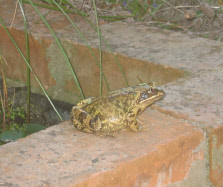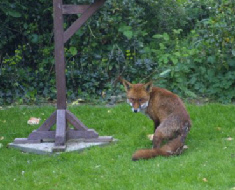Talk to us here at Rochford Life : 0786 342 7294 or E-mail us. For other numbers see individual pages.


Make a point of visiting us weekly! Tell a friend about us.
Squirrels may be fun to watch but they’ll steal the bird food, raid birds’ nests and can caused damage. Best not to encourage them.
Moles, heaven help you! Their digging can devastate lawns or upset vegetable patches. They are said to prefer larger gardens near the countryside and dislike sandy soils, so there is good and bad news depending on where you live. Trying to get rid of them tends be a somewhat thankless task. On the positive side use the aerated soil for other parts of the garden or rake it thinly over the lawn as a dressing. If you have a solitary mole hill you could leave it and it become a home for solitary bees, or as a place for robins and thrushes to feed.
Bats, despite a bad press, are clean and sociable and clear night skies of insects. If you want to encourage them, the advice is dig a pond which will encourage insects and provide a drinking area for them, or grow plants that encourage insects – nectar and pollen rich ones do well. They are a protected species. You’ll only see them in the twilight when they first come out at night and they move very fast.
What does that leave us? Mice, voles, and shrews, the little creatures. If you have a shed you may find you have provided a home for mice. All well and good until you leave the back door open and they invade the house. Not so funny. Mice indoors seem to eat anything. Voles prefer a damper habitat but may chew the bark off young trees and they don’t enter houses. They tend to eat only greenery. Shrews go for insects and larvae and spiders and woodlice but only tend to inhabit larger gardens, preferring rough pasture and so on.
Well, that’s probably enough to be going with. After all that it won’t be so much a case of you choosing what wildlife you will have, more a case of who turns up and takes a fancy to your patch! Most of what we have described you will never see; it’s only when there has been snow that you suddenly realise you have many visitors to your garden, but don’t get too excited by the tracks, a number of them are no doubt local cats!
But enjoy looking anyway!
The following is a quote from Monty Don in Gardener’s World which we came across since we wrote the above article, which we felt spoke much wisdom:
“for the past 15 years or so we have had hardly any real problems with pests here at Longmeadow. Yes, the odd slug occasionally gets medieval with a tray of seedlings but we never seem to lose anything we could not spare and, in the scheme of things, that is no loss at all. Whilst the rest of the country bemoaned the plague of slugs, I would look on bemused and wonder if people were exaggerating or we had simply been spared.
The smugness came from my belief —which I still adhere to — that the reason our garden was so relatively untroubled was because it was run organically with the right balance of pests and predators. If any one pest became a slight problem there would quickly be an upsurge in a predator to take care of it. So the thrushes, blackbirds, toads, beetles and hedgehogs in this garden feast upon slugs.
This predatory balance depends upon two things. The first is a rich and wide variety of birds, mammals, amphibians and insects. To get that you have to have suitable habitats, plants and, critically, go out of your way to not kill them with poisonous chemicals.
The. second thing you need, which many people forget, are pests. If you have zero pests then you will quickly lose predators. This means having the plants and habitats that will attract some pests. This will seem impossibly perverse to many gardeners but it is true. A healthy garden has a rich ecosystem that will include a food chain for all creatures, from the bacteria in the soil to the hawks taking song thrushes. Intervene clumsily and the garden will suffer.”
Moles, heaven help you! Their digging can devastate lawns or upset vegetable patches. They are said to prefer larger gardens near the countryside and dislike sandy soils, so there is good and bad news depending on where you live. Trying to get rid of them tends be a somewhat thankless task. On the positive side use the aerated soil for other parts of the garden or rake it thinly over the lawn as a dressing. If you have a solitary mole hill you could leave it and it become a home for solitary bees, or as a place for robins and thrushes to feed.
Bats, despite a bad press, are clean and sociable and clear night skies of insects. If you want to encourage them, the advice is dig a pond which will encourage insects and provide a drinking area for them, or grow plants that encourage insects – nectar and pollen rich ones do well. They are a protected species. You’ll only see them in the twilight when they first come out at night and they move very fast.
What does that leave us? Mice, voles, and shrews, the little creatures. If you have a shed you may find you have provided a home for mice. All well and good until you leave the back door open and they invade the house. Not so funny. Mice indoors seem to eat anything. Voles prefer a damper habitat but may chew the bark off young trees and they don’t enter houses. They tend to eat only greenery. Shrews go for insects and larvae and spiders and woodlice but only tend to inhabit larger gardens, preferring rough pasture and so on.
Well, that’s probably enough to be going with. After all that it won’t be so much a case of you choosing what wildlife you will have, more a case of who turns up and takes a fancy to your patch! Most of what we have described you will never see; it’s only when there has been snow that you suddenly realise you have many visitors to your garden, but don’t get too excited by the tracks, a number of them are no doubt local cats!
But enjoy looking anyway!
The following is a quote from Monty Don in Gardener’s World which we came across since we wrote the above article, which we felt spoke much wisdom:
“for the past 15 years or so we have had hardly any real problems with pests here at Longmeadow. Yes, the odd slug occasionally gets medieval with a tray of seedlings but we never seem to lose anything we could not spare and, in the scheme of things, that is no loss at all. Whilst the rest of the country bemoaned the plague of slugs, I would look on bemused and wonder if people were exaggerating or we had simply been spared.
The smugness came from my belief —which I still adhere to — that the reason our garden was so relatively untroubled was because it was run organically with the right balance of pests and predators. If any one pest became a slight problem there would quickly be an upsurge in a predator to take care of it. So the thrushes, blackbirds, toads, beetles and hedgehogs in this garden feast upon slugs.
This predatory balance depends upon two things. The first is a rich and wide variety of birds, mammals, amphibians and insects. To get that you have to have suitable habitats, plants and, critically, go out of your way to not kill them with poisonous chemicals.
The. second thing you need, which many people forget, are pests. If you have zero pests then you will quickly lose predators. This means having the plants and habitats that will attract some pests. This will seem impossibly perverse to many gardeners but it is true. A healthy garden has a rich ecosystem that will include a food chain for all creatures, from the bacteria in the soil to the hawks taking song thrushes. Intervene clumsily and the garden will suffer.”
To return to front ‘Growing Stuff’ page, please CLICK HERE

5. Encouraging Garden Wildlife
Well the first question has to be, do you want to encourage wildlife? Well, with limited space let’s limit ourselves to reptiles and then mammals.
If we start with reptiles then lizards, frogs and snakes are no problem. Each of these eat insects or bugs and therefore do a clearing up job for us. Unless you have lots of long grass you’re unlikely to have snakes around, more likely slow-worms in your compost heap - again no problem.
If we start with reptiles then lizards, frogs and snakes are no problem. Each of these eat insects or bugs and therefore do a clearing up job for us. Unless you have lots of long grass you’re unlikely to have snakes around, more likely slow-
Moving on to mammals, some you certainly don’t want to encourage. Rats are definitely out, so be careful about putting out unused food on compost heaps. The rule is put it on bird tables in small amounts.
Badgers, in our opinion, are also a nuisance because a) they kill hedgehogs that you do want and b) they are highly destructive. If you have a hole smashed in a wooden fence, it may well be a badger and they are creatures of habit and get very annoyed if you try to change their chosen pathways. You will need to go to great lengths (and I’m not suggesting poisoning them) to put them off.

Foxes are a nuisance because they can dig up your garden and they often leave an acrid smell behind them, but as they jump high fences you’re probably stuck with them. They do sometimes also kill hedgehogs but not so much as Badgers.
So yes, you do want Hedgehogs because they clear up slugs and other insect pests. Contrary to popular belief don’t feed them bread (too hard to digest) or cows’ milk (too rich) but dog or cat food and biscuits does go down well with them. Otherwise they’ll go for worms, beetles etc. Leaving stick piles or leaf piles around the place in Autumn may encourage them to nest with you, but if you have bonfires, be careful to check out the pile before you light it.